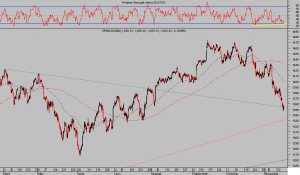Hoy comienza la cuenta atrás para avanzar en las negociaciones que deben encontrar pactos y soluciones para evitar el temido precipicio fiscal, y sólo faltan 12 sesiones del Congreso para finalizar el año.
Ha comenzado la cuenta atrás y los noticiarios se aventuran a anticipar un esbozo de la situación, observen el interesante artículo publicado por Wall Street Journal, supuestamente retransmitido desde la Casa Blanca en el que se asegura que no hay grandes expectativas de consenso y por ello presumiblemente decidirán aplazar las decisiones para 2013, vean:
«White House officials are in advanced internal discussions about a plan to replace the sweeping spending cuts set to begin in January with a smaller, separate package of targeted spending cuts and tax increases, people familiar with the planning said. The spending cuts, known as the «sequester,» will begin in January unless the White House and Congress intervene. They would cut spending by roughly $100 billion next year, and then for eight additional years, hitting a number of federal programs, including military programs, embassy security and state aid.
The discussions are just one part of a complicated set of possibilities as Washington deals not only with the looming spending cuts but also the expiration of the Bush tax cuts and other traditional year-end priorities, such as finding a way to halt the scope of the Alternative Minimum Tax. While moving along separate tracks, it is also possible these three policy issues could be wrapped up into one universal deal.
The White House is set to start negotiations with Republican and Democratic congressional leaders Friday.
By postponing the sequester cuts, Washington would essentially push off a number of large deficit-reduction decisions into mid-2013. This would include a long-term plan to replace the remaining sequester cuts, a plan to overhaul the tax code, and separate decisions about how to restructure Medicare and Medicaid.
The plan that has been discussed by White House officials is similar in many ways to what lawmakers have discussed. It would terminate the spending cuts for a period of six to 12 months, and replace the cuts with more targeted reductions and revenue increases. House Republicans have proposed a similar model, though they have called for terminating the cuts to defense programs only and haven’t accepted a deal to include tax increases as part of any package.
A White House spokeswoman declined to comment!
El mercado se presenta nervioso ante la cita del Congreso de esta taarde y además decepcionado con las noticias macro conocidas esta semana y también las microeconómicas que se van publicando.
La divergencia alcista que muestra el gráfico siguiente, junto con las lecturas de los famosos y generalmente precisos Summation Indices podrían introducir motivos para estabilizar la situación de ventas y caídas iniciada en septiembre.
SP500 60 minutos
Conviene considerar la elevada cantidad de fondos en liquidez y esperando a entrar en el mercado, vean la interesante exposición del analista Frank Curzio ayer publicada:
«On Wednesday, executives from 12 of the largest companies in the world – including JPMorgan Chase, General Electric, Wal-Mart, IBM, and Coca-Cola – met with President Obama behind closed doors. The meeting was held to come up with a solution for raising taxes and cutting government spending.
You see, the government is quickly approaching the brink of a «fiscal cliff.» That’s the term being used to describe the potential problem the government faces when certain tax laws expire on January 1. Most investors are expecting higher taxes. But the big question is, how high?
This uncertainty has driven a tremendous amount of cash to the sidelines.
As of last week, the net long exposure of the «smart money» – in other words, hedge funds – to long and short equity funds is only 24%, according to Bank of America Merrill Lynch. Historically, these hedge funds are 40% long. That means potentially hundreds of billions of dollars could soon pour into the market.
About $1.7 trillion in cash is also sitting on corporate balance sheets. That’s the equivalent of 11% of our gross domestic product.
All this idle cash is waiting for the right moment to rotate back into stocks. That moment could be less than a month away… and it could push stocks much higher from current levels».
